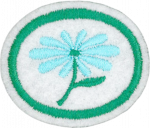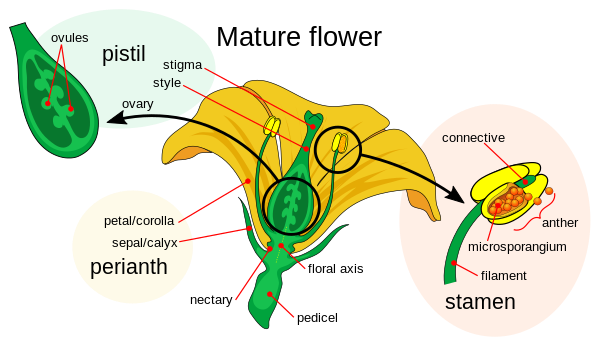AY Honors/Flowers/Answer Key/es
From Pathfinder Wiki
| Flores | ||
|---|---|---|
| Asociación General
|
Destreza: 2 Año de introducción: 1928 |
|
Requisitos
| Conexión Logros para la Investidura: Esta especialidad está relacionada con los requisitos de Logros para la Investidura para ORIENTADOR DE NUEVAS FRONTERAS Estudio de la naturaleza que requiere (como una de dos opciones) dibujar, fotografiar o coleccionar fotos de 20 clases de flores similar al requisito #1 de esta especialidad. Esta especialidad es una elección popular para la especialidad de la categoría de Estudio de la naturaleza de nivel de destreza 2 o 3 requerido para los ORIENTADORES DE NUEVAS FRONTERAS. |
1
Dibujar o fotografiar 35 clases de flores e identificarlas correctamente.
2
Dibujar y etiquetar o bien señalar las partes de una flor: gineceo (pistilo), estambre, pétalo, sépalo
- Pistil
- The pistil is the female portion of the flower located at the center of the blossom. It consists of the style, stigma, and ovary.
- Stamen
- The stamen is the male portion of the flower, and it is clustered around the pistil. It includes the filament and anther. Most flowers have multiple stamens.
- Petal
- Also known as the corolla, the petals enclose the reproductive organs of a flowering plant. They are often brightly colored to attract pollinators, and lend beauty to the plant.
- Sepal
- Also known as the calyx, the sepal encloses the flower when it is in bud form. When the sepals open, the petals are revealed. They are often (but not always) green and leafy-looking.
3
Nombrar seis familias de flores y sus características distintivas. Nombrar al menos dos flores en cada familia.
4
Describir la historia de vida de una flor, incluido el papel desempeñado por los insectos o el viento en la polinización.
- A seed needs warmth and water to grow roots.
- The flower sprouts up and down at the same time, send a shoot upwards, and a root downwards.
- The flowers grow more leaves.
- The blossoms open.
- Bees and other insects pollinate the flowers.
- The flowers form seeds.
- The seeds are dispersed and take root.
- The cycle repeats.
5
Nombrar al menos dos plantas que son venenosas al tacto y diga cual, si es que hay alguna, se encuentran en su localidad.
6
Hacer tres de los siguientes:
6a
Arreglar, dibujar o fotografiar una serie de por lo menos seis flores, mostrando en orden los colores del arco iris: rojo, naranja, amarillo, verde, azul y violeta.
!style="background:yellow" align=left|
- Goldenrod
- Daffodil
- Dandelion
- Butter-and-eggs
- Evening Primrose
- Sunflower
6b
Presentar flores frescas, presionadas o secas que tengan cinco pétalos, cuatro pétalos, tres pétalos y ningún pétalo.
6c
Distinguir y nombrar dos de cinco flores silvestres o cultivadas por su olor con los ojos vendados.
6d
Hacer una lista de las flores que ha observado que son visitadas por alimentación por los siguientes:
- i. Aves:
- ii. Abejas:
- iii. Abejorros (moscardón):
- iv. Mariposas:
- v. Mariposas nocturnas (Palomillas):
6e
Mirar una flor por lo menos 10 minutos en el sol y por lo menos 10 minutos después de anochecer, e informar sobre cualquier insecto visitante. Indicar el número, clase de visitante y nombre de la flor.
Referencias
Categories:
- Categoría: Tiene imagen de insignia
- Adventist Youth Honors Answer Book/Honors/es
- Adventist Youth Honors Answer Book/es
- Adventist Youth Honors Answer Book/Skill Level 2/es
- Categoría: Libro de respuestas de especialidades JA/Especialidades introducidas en 1928
- Adventist Youth Honors Answer Book/General Conference/es
- Adventist Youth Honors Answer Book/Nature/es
- Adventist Youth Honors Answer Book/Nature/Primary/es
- Adventist Youth Honors Answer Book/Stage 0/es
- Adventist Youth Honors Answer Book/IAConnection/es



